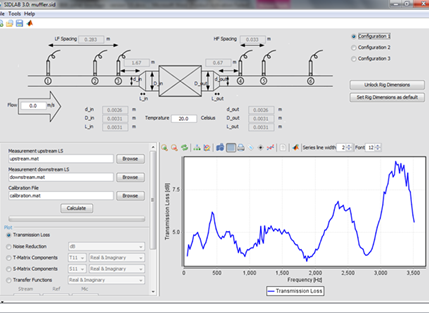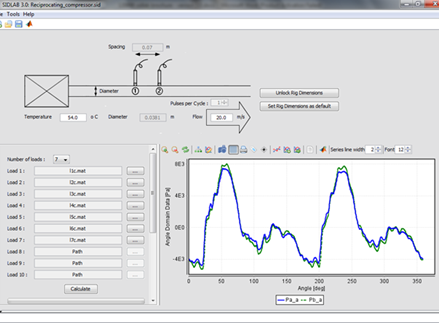SIDLAB measurements
This is a post-processing module for measurement data. It handles two types of measurements:
Characterization of the passive properties of two-port elements (e.g. muffler or filter).
Source Characterization of one-port elements (e.g. engine or compressor).
The measured results can be imported easily to SIDLAB Acoustics to include with other standard elements in a network.
Passive two-port
This part calculates the passive acoustic properties of two-port elements from the measured transfer functions. The two-source location technique is used to create the necessary two test cases. The two microphone method is used for the wave decomposition with three microphone positions on each side, i.e., six microphones, in order to cover a wider frequency range. Three microphone configurations are available. The third configuration comprises only two microphones on each side. It is possible to compensate the effect of inlet and outlet cones before and after the test object.
Input Data
Rig dimensions, temperature and flow data.
Measured transfer functions in the frequency domain between the six microphones and the upstream loudspeaker signal.
Measured transfer functions in the frequency domain between the six microphones and the downstream loudspeaker signal.
Calibration transfer functions between the six microphones.
Calculated Results
The transfer and scattering matrices of the two-port element.
Transmission Loss in dB
Noise Reduction in dB, narrow band, octave and third octave.
Correct the TL results for another temperature to simulate a real engine condition.

Active one-port
This part calculates the acoustic properties of one-port sources from the measured time domain data of the pressure transducers. The two microphone method is used for the wave decomposition. Synchronized time domain averaging is used to average the data using a tacho signal. The results are calculated in the order domain and the frequency domain using the rotational speed. Several loads have to be measured. The last load is not included in the calculations but used for verification.
Input Data
Rig dimensions, temperature and flow data.
The dynamic pressure in the time domain at two positions, for different loads.
A pulse signal in the time domain from a tacho directed at a rotating part in the source.
The rotational speed of a rotating shaft in the machine.
Calculated Results
The dynamic pressure in the angle domain at the two positions.
The source strength and the source impedance.
